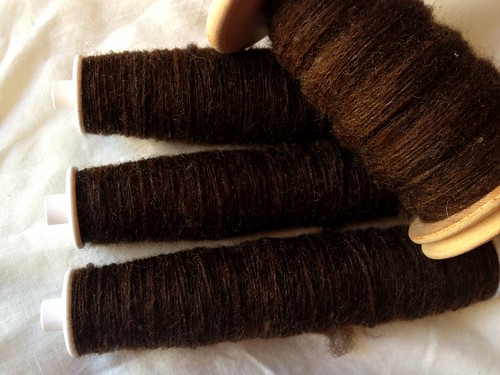I could certainly do that, but one of the things spinning for socks is accomplishing for me is to "break" my default comfort spinning. Yes, I can spin different weights of singles in order to create different weights of yarn, but my singles always nearly have the same twist angle and my plied yarns tend to be more-or-less "balanced" coming off the niddy noddy (usually 1/2 or 1 twists of the finished skein). And for general purposes, spinning this type yarn is definitely good enough. But, I really want to get out of my "comfort" zone. I want to become a better spinner and not just rely on my general default comfort spinning. I wanted to become a better "technical spinner".
So, I spoke with my SpinU teacher, Sandy, over at Purlescence about what I was doing incorrectly. (Notice that I didn't say "wrong" here, because what I was doing wasn't WRONG, per se, but incorrectly for the application I needed.)
After discussing which wheel and ratios I was using and my technique, she determined that I was doing several things (when combined) were the incorrect application for spinning socks -- primarily which wheel, my drafting technique, and my take-up. I hadn't considered these things before, but once I thought about it, it made absolute sense.
So later in the week, I went to my LYS with my Traddy in tow and I sat with Sandy to over the technical aspects of spinning for socks using some superwash merino / nylon blend fiber. She made some corrections to how I spin and went into a lot more detail about my application of each of the items that we had briefly discussed before.
- I was not using a wheel with a high enough ratio -- my Sidekick -- despite using the high speed whorl on it. It has a 13.75" wheel diameter and it's highest ratio the Sidekick is also 13.75:1. Instead, I should be using my biggest wheel, the Traddy, which has a 22" wheel (and 17:1 ratio), or even my Kiwi with its 17.5" wheel (with a 14:1 ratio).
(It is possible to spin for socks on the Sidekick, with some change in my technique as noted below) - I need to draft a lot more slowly. When I demonstrated how I was drafting, she said I was drafting much too fast. I had a cadence of 1:1 --- one press of the pedal = one draft. Consequently, this part is going to require some conscious effort in my part to draft a heckuva lot slower than I'm used to doing.
- My brake band needed a lot more slack. Sandy was spinning socks on the Sidekick, but she showed me how little slack the brake band hand. In general, I use a moderate amount of take-up on the brake band. However, it turned out I was using far too much than was necessary to get the necessary twist. (Also, because the Traddy is a double drive, d have to make sure that the differential between the bobbin and the whorl was "low". With Scotch Tension wheels, I just need to ensure that my brake band is fairly loose.)
Adding these bits of information really was an eye opener. I had always pretty much just thought it was a matter of wheel ratios for spinning different yarn types. I thought about my own drafting techniques and how much take up I normally use on my various wheels, and realized that I have a few gaps in my spinning knowledge that I need to fill, especially if I want to get into spinning more 'technically' challenging yarns.
Luckily, Sandy has mentioned that Purlescence will do some SpinU intensives -- concentrating on one aspect of spinning (i.e. JUST woolen or JUST color maintenance) for a number of weeks. I think I shall try and take a few of these intensives so as to "break" my spinning and thus become better at it.
I'm very lucky that I have a resource that I can go to for advice to help fix my mistakes and help me get better at this whole spinning thing. I think I shall take some of what I learned from Sandy, make the adjustments necessary, and practice a bit to spin technically and correctly for socks.
Wish me luck.















































